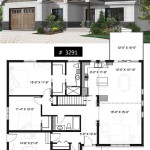Understanding Home Design Plans and Elevations
Home design plans and elevations are fundamental components of the architectural process. They serve as both the blueprint for construction and the visual representation of the intended final product. Understanding these plans is crucial for anyone involved in building or renovating a home, from architects and builders to homeowners and investors. This understanding ensures accurate communication, minimizes costly errors, and allows for a more informed decision-making process throughout the project.
A comprehensive set of home design documents typically includes several types of drawings, each serving a specific purpose. These can encompass site plans, floor plans, elevations, sections, and detailed drawings. Each of these contributes to a full understanding of the project’s design and construction requirements.
The accuracy and clarity of home design plans and elevations are paramount. Errors or ambiguities in these documents can lead to misinterpretations during construction, resulting in delays, increased costs, and potentially compromising the structural integrity or aesthetic appeal of the home. Thus, employing experienced professionals and utilizing advanced software are critical for creating accurate and comprehensive plans.
The Significance of Floor Plans
A floor plan is a scaled diagram illustrating the arrangement of rooms within a building viewed from above. It depicts the layout of walls, doors, windows, and other fixed elements at a specific level of the building. The floor plan is considered the cornerstone of any architectural drawing set, as it defines the functional organization and spatial relationships within the structure.
Floor plans are indispensable for several reasons. Firstly, they provide a clear overview of the size and shape of each room, allowing for effective space planning and furniture arrangement. Secondly, they illustrate the flow of movement within the house, influencing circulation patterns and the overall functionality of the design. Thirdly, they serve as a basis for other drawings, such as elevations and sections, ensuring consistency and coordination across the design.
Furthermore, a complete floor plan includes critical information such as dimensions, door and window sizes, and locations of plumbing and electrical fixtures. This information is essential for contractors and subcontractors to accurately estimate material requirements and plan the installation of various building systems. Accurate dimensions are crucial for ordering materials and ensuring proper fit during construction. Likewise, the locations of plumbing and electrical fixtures dictate the placement of pipes, wiring, and outlets, requiring precise coordination with the structural elements of the building.
Modern floor plans often incorporate symbols and abbreviations to represent various features, such as plumbing fixtures (toilets, sinks, showers), electrical outlets and switches, and construction materials. These symbols are standardized throughout the architectural industry to ensure clear communication and prevent misinterpretations. Familiarity with these symbols is beneficial for anyone interpreting floor plans, enabling them to understand the intended design and construction details.
The development of a floor plan typically involves a collaborative process between the architect, the client, and sometimes other consultants. The architect works closely with the client to understand their needs and preferences, translating these requirements into a functional and aesthetically pleasing layout. The floor plan may undergo several iterations as the design is refined and adjusted based on feedback and site constraints.
Beyond the basic layout, floor plans can also indicate the types of flooring, wall finishes, and ceiling heights in each room. This level of detail is especially important for renovations and additions, where it is crucial to match existing materials and finishes or to introduce complementary elements. The floor plan also aids in determining compliance with building codes and accessibility requirements, addressing aspects like minimum room sizes, egress routes, and barrier-free access.
Understanding Home Elevations
Elevations are orthographic projections depicting the exterior faces of a building. They provide a two-dimensional representation of the building's vertical surfaces, showcasing the architectural style, materials, and detailing. Unlike floor plans, which show the interior layout, elevations illustrate the external appearance of the structure from different viewpoints.
Typically, a complete set of home design plans will include elevations for all four sides of the building: front, rear, left, and right. These elevations are labeled accordingly and provide a comprehensive view of the building's facade from every angle. Elevations are essential for visualizing the overall aesthetic of the home and for understanding how it will relate to its surroundings.
Elevations provide crucial information about the building’s exterior features, including window and door styles, rooflines, cladding materials (e.g., brick, siding, stucco), and architectural details (e.g., cornices, moldings, trim). These details are essential for accurately constructing the building and achieving the intended visual effect. They also offer information about the vertical dimensions and heights of various elements, such as the roof, windows, and doors.
Furthermore, elevations indicate the relative ground level and how the building connects to the landscape. This information is critical for site grading, drainage planning, and ensuring accessibility. The elevations also depict any exterior features such as porches, decks, balconies, and chimneys, contributing to a complete understanding of the building’s external appearance.
Modern elevations often incorporate shading and textures to simulate the appearance of different materials under various lighting conditions. This enhances the visual realism of the drawings and helps clients and contractors visualize the final product. Elevations also include annotations that specify the types, sizes, and colors of exterior materials, ensuring accurate material selection and installation.
The creation of elevations is closely linked to the floor plans and other drawings. The elevations must accurately reflect the layout and dimensions shown in the floor plans, ensuring consistency and coordination across the design. The elevations are also used to determine the placement and size of windows and doors, taking into account factors such as natural light, ventilation, and privacy. They also aid in verifying compliance with building codes and zoning regulations, addressing aspects such as height restrictions, setback requirements, and allowable building materials.
Elevations are critical for obtaining building permits and approvals from local authorities. These agencies review the elevations to ensure that the proposed building complies with zoning regulations and design guidelines. Accurate and detailed elevations demonstrate the project’s compliance and facilitate the permitting process.
The Importance of Sections and Details
While floor plans and elevations provide a comprehensive overview of the home's layout and exterior appearance, sections and detailed drawings offer a more in-depth understanding of the building's internal structure and construction methods. These drawings are essential for ensuring the structural integrity and performance of the building.
A section is a vertical cut through the building, revealing the internal construction of walls, floors, and roofs. It illustrates how different building components are assembled and connected and how the building interacts with the ground. Sections are crucial for understanding the structural system of the building and for verifying compliance with building codes related to fire safety and energy efficiency.
Typically, a set of home design plans will include one or more sections, depending on the complexity of the building. These sections are often taken through critical areas of the building, such as staircases, bathrooms, and kitchens, where there are significant changes in elevation or construction details. Sections illustrate the height of each floor, the thickness of walls and floors, and the type of insulation used.
Detailed drawings, on the other hand, provide a close-up view of specific building components or assemblies, such as window and door details, wall sections, and roof overhangs. These drawings show the precise dimensions, materials, and construction methods used to create these elements. Detailed drawings are essential for ensuring that the building is constructed according to the architect's specifications and that all components are properly integrated.
Detailed drawings are particularly important for complex or custom building features, where standard construction methods may not apply. They allow the architect to clearly communicate their design intent to the contractors and subcontractors, minimizing the risk of errors or misinterpretations. These drawings often include annotations that specify the types of materials, fasteners, and finishes to be used.
The creation of sections and detailed drawings requires a thorough understanding of building science and construction practices. The architect must consider factors such as structural loads, thermal performance, moisture control, and durability when designing these details. Accurate and well-detailed sections and drawings are essential for ensuring the long-term performance and sustainability of the building.
Sections and details are also crucial for resolving potential conflicts between different building systems. For example, the section may reveal clashes between plumbing pipes and structural beams, allowing the architect to modify the design to avoid these conflicts. Similarly, detailed drawings can help to coordinate the installation of electrical wiring and mechanical ductwork, ensuring that these systems are properly integrated into the building.
In conclusion, home design plans encompassing floor plans, elevations, sections, and detailed drawings are essential tools for successful construction and renovation projects. A thorough understanding of these plans, combined with clear communication and collaboration among all stakeholders, contributes to a smooth and efficient building process and a satisfactory final result.

20 X 25 House Plan And Elevation Design Autocad File Cadbull 982

Architecture House Plan And Elevation Complete Drawing

20x52 6 Residential Dream House With Its Floor Plan And Elevation

Scheme Of The Tested Single Family House A Front Elevation B Scientific Diagram

33x50 Modern House Plan And Elevation

Floor Plan And Elevation Of Modern House

Floor Plan And Elevations For The New House Wildfire Interiors

50x62 Ultra Modern House Design Plan Elevation

900 Ground Floor Elevation Ideas In 2024 Small House Design Front

Riverside Contemporary Home Design Sater Collection








